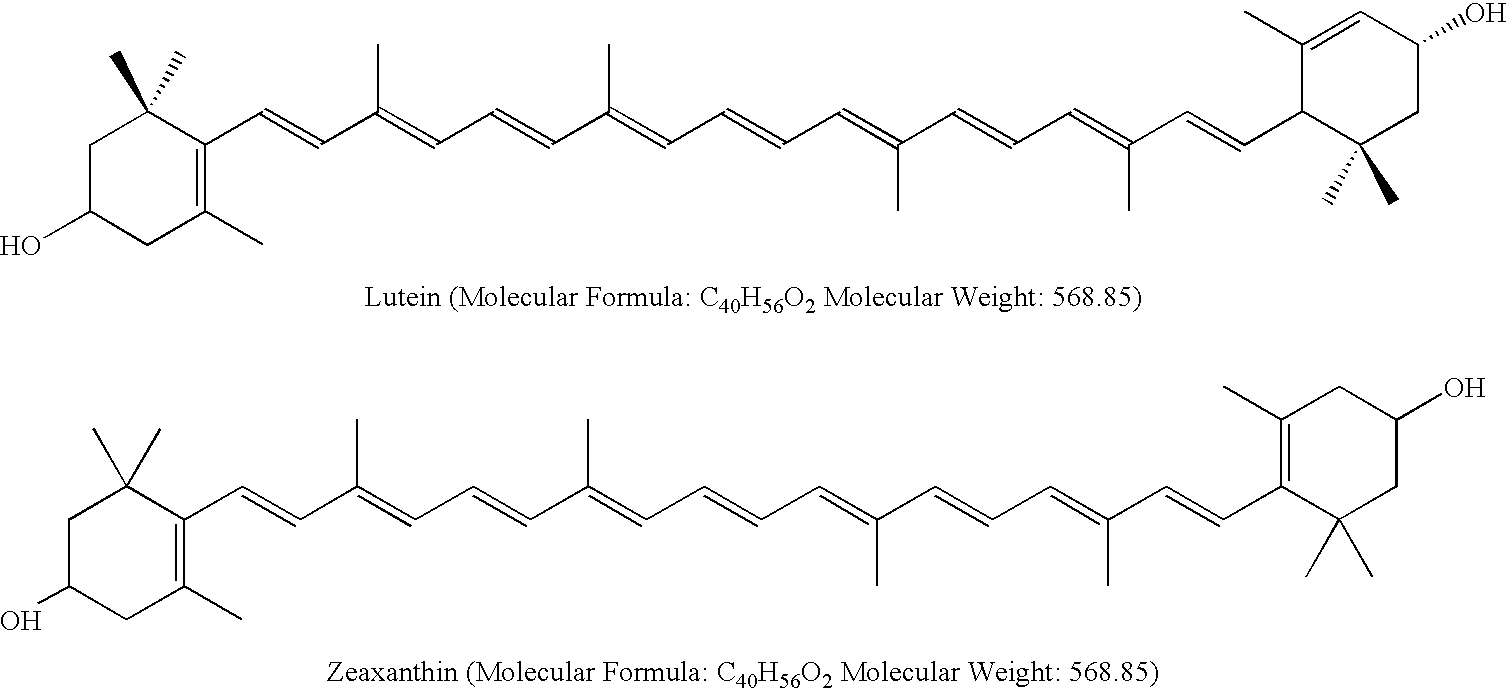Method for preparing high-content food-grade zeaxanthin
a technology of zeaxanthin and high content, applied in the field of biochemicals, can solve the problems of low final product yield, prolonged reaction duration, and helpful to increase product yield, and achieve the effect of high product yield
- Summary
- Abstract
- Description
- Claims
- Application Information
AI Technical Summary
Benefits of technology
Problems solved by technology
Method used
Image
Examples
example 1
[0023]Weigh 30 g xanthophyll crystal from saponification of marigold oleoresin (wherein the total carotenoid is 88.5% and the proportions of lutein and zeaxanthin account for 92% and 7% of total carotenoid, respectively, the rest being a few other carotenoids). Mix with 540 ml glycol and stir and dissolve for 1.0 hr under 80° C. Heat up the mixture to 90° C. after dissolution is completed, and instill 40 g 6.85 mol / L sodium methoxide solution, and addition of alkali catalyst is to be completed within 45 min. Reaction is to take place at this temperature, and the lutein and zeaxanthin in the reaction solution are to be sampled at an interval of 0.5 hr after reaction for 4.0 hr and analyzed with high performance liquid chromatographic method for their proportions, to get a measurement of 89.7% proportion of zeaxanthin of total carotenoid in the reaction liquid after 8.5 hr. Drop the temperature of reaction mixture to 70° C., and add a mixture composed of 1000 ml deionized water and 60...
example 2
[0026]Weigh 40 g xanthophyll fatty acid ester refined from marigold oleoresin (wherein the carotenoid fatty acid ester content of total carotenoid is 72.5%, and the proportions of lutein and zeaxanthin in total carotenoid are 91.6% and 6.8%, respectively, the rest being a few other carotenoids). Fully mix xanthophyll fatty acid ester with 470 ml propylene glycol and dissolve the mixture under 70° C. Heat up to 85° C. after dissolution is completed. Add 110 g 2.92 mol / L sodium tertiary butyl alcohol solution drop by drop, and it is determined after reaction standing for 14.5 hr with high performance liquid chromatographic method that zeaxanthin wherein accounts for an 84.6% proportion of the total carotenoid. Cool down to 70° C. and add a mixed liquid composed of 1000 ml deionized water and 600 ml food-grade ethanol to dilute the reaction liquor. Extract and filter out the crystals from separation, with a mixture of water and ethanol for washing during the extracting and filtering pr...
examples 3-4
[0028]Implementation processes for Examples 3-4 are similar to those of Examples 1-2, and the analytical results for their main technical parameters and some product characters are listed in Table 1.
[0029]
TABLE 1Analysis of Main Technical Parameters and Some Product Characters inExamples 1-4ItemExample 1Example 2Example 3Example 4Type of Raw MaterialsXanthophyll CrystalXanthophyll FattyXanthophyll CrystalXanthophyll FattyAcid EsterAcid EsterQuantity of Raw Material30 g40 g30 g40 gType of SolventGlycolPropylene GlycolPropylene GlycolGlycol + PropyleneGlycol (1:1)Quantity of Solvent540 ml470 ml450 ml400 mlType of Catalyst6.85 mol / L2.92 mol / L1.96 mol / L5.15 mol / LSodium MethoxideSodium TertiarySodium DimethylSodium EthoxideSolutionButyl AlcoholSulfoxide SolutionSolutionSolutionQuantity of Catalyst40 g110 g150 g83 gReaction Temperature90° C.85° C.80° C.90° C.Reaction Duration8.5 hr14.5 hr6.0 hr12.0 hrSeparating MethodCentrifugalExtraction andExtraction andCentrifugalFiltrationFiltrationQu...
PUM
| Property | Measurement | Unit |
|---|---|---|
| temperature | aaaaa | aaaaa |
| temperature | aaaaa | aaaaa |
| temperature | aaaaa | aaaaa |
Abstract
Description
Claims
Application Information
 Login to View More
Login to View More - R&D
- Intellectual Property
- Life Sciences
- Materials
- Tech Scout
- Unparalleled Data Quality
- Higher Quality Content
- 60% Fewer Hallucinations
Browse by: Latest US Patents, China's latest patents, Technical Efficacy Thesaurus, Application Domain, Technology Topic, Popular Technical Reports.
© 2025 PatSnap. All rights reserved.Legal|Privacy policy|Modern Slavery Act Transparency Statement|Sitemap|About US| Contact US: help@patsnap.com

